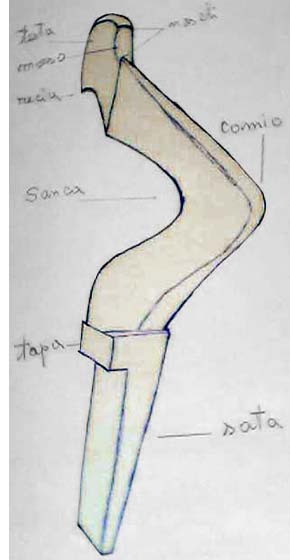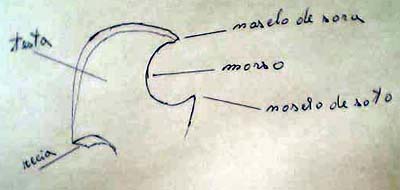- Forcoe Crutches
 The forcoe are the crutches used to row Venetian way; they are shaped in various manners according with the model of boat and with the rowing position. The forcoe are the crutches used to row Venetian way; they are shaped in various manners according with the model of boat and with the rowing position.
They can be mainly subdivided in stern and stem crutches.
The stern crutch is quite a complex tool, that often shows two oar slots: the lower one is used when only one man push the boat, the upper one when multiple oarsmen are present, or when it is necessary for the stroke to row standing on the nerva (border of the boat).
The ansate shape and the easy escape of the row from the crutch are for manoeuvring: the oar, indeed, acts on the crutch not only in the main slots, but in many other positions, allowing, I.E. to row backwards and to turn the boat 360° on its own axis.
In the stroke crutch of the gondola (photo on the right) nine positions oar/crutch can be counted.
The bowman crutches are simpler, with only one slot for the oar, but still they present a variety of shapes according with the kind of boat they are for.
It exists a second classification for crutches depending on the use:
Working boats - usually more linear and simple to reduce the bulk;
Pleasure boats - pliant and often carved and gilded (velae);
Regatta boats sized and shaped by each racer and missing of the tapa to allow the personalized positioning of the crutch in the engobe (nogaro) by mean of small wedges (penoe).
 Essential parts of the forco Essential parts of the forcola are:
- testa (head)
- morso (bite)
- nase
lo de sora
(upper nose)
- nase
lo de soto
(lower nose)
- recia (ear)
- sanca e comio
(elbow)
- tapa (stopper)
- sata (leg)
A good forcola is carved in a piece of a walnut trunk, split with iron wedges (not sawed) to keep the continuity of the wood vein; the piece obtained this way, similar to the one used for the beech rows, is called stela (star).
- Oars
The oar to row Venetian way is taken from a beech stela, that is a young trunk or one vertically split with iron wedges (overall as today, when tropical woods substitute the beech), to ensure the maximum elasticity and sturdiness with the smallest diameter. To make up for the lack of width for the blade, this is accomplished with the inlay of asymmetrical side knives (cortei) made of very hard wood.
The parts of the oar are:
- giron (handle) - the cylindrical handgrip;
- entrar (the entering) - the part that works on the crutch;
- copo (pantile) - the part with asymmetrical cross-section between the entrar and the blade;
- pa
la (blade)
- corteo
longo (long knife) - on the upper part of the blade;
- corteo curto (short knife) - on the lower part of the blade, the first to enter in the water;
- soraosso (over-bone) - a hard wood dowel that can be inlayed in the entrar to repair an oar eaten away by the rubbing on the crutch, or to improve its elasticity.
The round handgrip develops in the blade with smooth splines, without any discontinuity.
The cross-section of the copo is a convex angle on the upper face and a convex arc on the lower: this way, the lower half of the oar results more weighty than the upper one, aiding the movements in (premer) and out of (stár) the water that are typical of the rowing Venetian way.
The lengths of the Venetian oars vary, depending from the boats, from about two metres and a half up to over five metres. Stern oars are slightly different from bow ones, which are a little shorter and with more symmetric copo.
|